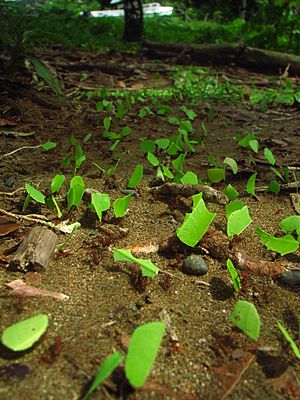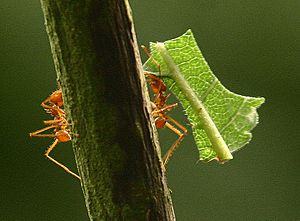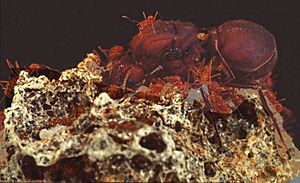Leaf-cutter ant facts for kids
Leafcutter ants are a group of 47 different types of ants. They are known for cutting leaves. These ants belong to two main groups, called Atta and Acromyrmex.
These special ants live in warm, tropical places. You can find them in South America, Central America, Mexico, and parts of the southern United States. Leafcutter ants are famous for their unique way of life: they cut fresh plants like leaves, flowers, and grasses. They don't eat these plants themselves. Instead, they use them to grow a special type of fungus in their nests. This fungus is their main food!
The Acromyrmex and Atta ants look quite similar. But you can tell them apart by looking closely at their bodies. Atta ants have three pairs of spines on their back and a smooth outer shell (exoskeleton) on their upper body. Acromyrmex ants, on the other hand, have four pairs of spines and a rougher outer shell.
After humans, leafcutter ants create some of the biggest and most complex animal societies on Earth. Their underground nests can become huge. In just a few years, the main part of their nest can grow to be more than 30 meters (about 98 feet) wide. Smaller tunnels can spread out even further, up to 80 meters (about 262 feet) away. These nests can cover a large area, from 30 to 600 square meters (about 323 to 6,458 square feet). Some of the biggest nests can be home to eight million ants!
Contents
Colony Life Cycle
Reproduction and Colony Founding
When it's time to start new colonies, young winged female and male ants fly out of their nests all at once. This big flight is called the revoada. Each female ant mates with many males. She collects a lot of sperm, which she needs to start her own new colony.
Once a female ant lands on the ground, she breaks off her wings. Then, she looks for a good underground spot to build her new home. It's very hard for these young queens to succeed. Only about 2.5% of them will manage to start a colony that lasts a long time. To begin her own fungus garden, the queen carries tiny pieces of the fungus from her old home in a special pocket in her mouth.
Colony Hierarchy
In a fully grown leafcutter ant colony, the ants are divided into different groups called castes. These groups are based mostly on the ant's size. Each caste has a different job to do. Both Acromyrmex and Atta ants have four main castes in their established colonies: minims, minors, mediae, and majors. The majors are also known as soldiers. Atta ants show more size differences between their castes than Acromyrmex ants do.
- Minims are the smallest workers. They take care of the young ants (brood) or look after the fungus gardens. Their heads are less than 1 millimeter wide.
- Minors are a bit bigger than minims. You can find many of them near the lines where ants are collecting food. These ants are the first to defend the colony. They constantly patrol the area around the foraging lines. They bravely attack any enemies that threaten their fellow ants. Their heads are about 1.8 to 2.2 millimeters wide.
- Mediae are the ants that go out to find food. They cut leaves and bring the pieces back to the nest.
- Majors are the largest worker ants. They act as soldiers, protecting the nest from anyone trying to get in. They also help by clearing big pieces of debris from the main foraging paths. Sometimes, they carry heavy items back to the nest. The biggest soldiers, like those from Atta laevigata, can be up to 16 millimeters long. Their heads can be 7 millimeters wide.
Life-style
Leafcutter ants are very important plant-eaters in Central American forests. They eat more plant material than all the plant-eating animals with backbones combined! Their underground nests can be huge. They are home to millions of ants. These ants also have a clever defense system. Smaller minor workers ride on top of the leaf pieces carried by the larger workers. They fight off attacks from parasitic flies.
Images for kids
See also
 In Spanish: Hormigas cortadoras de hojas para niños
In Spanish: Hormigas cortadoras de hojas para niños









